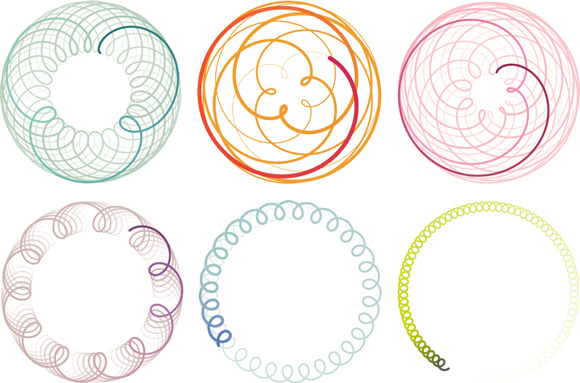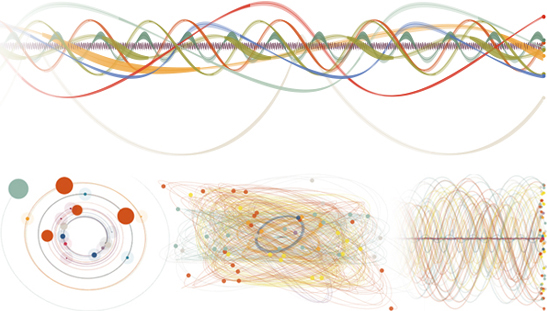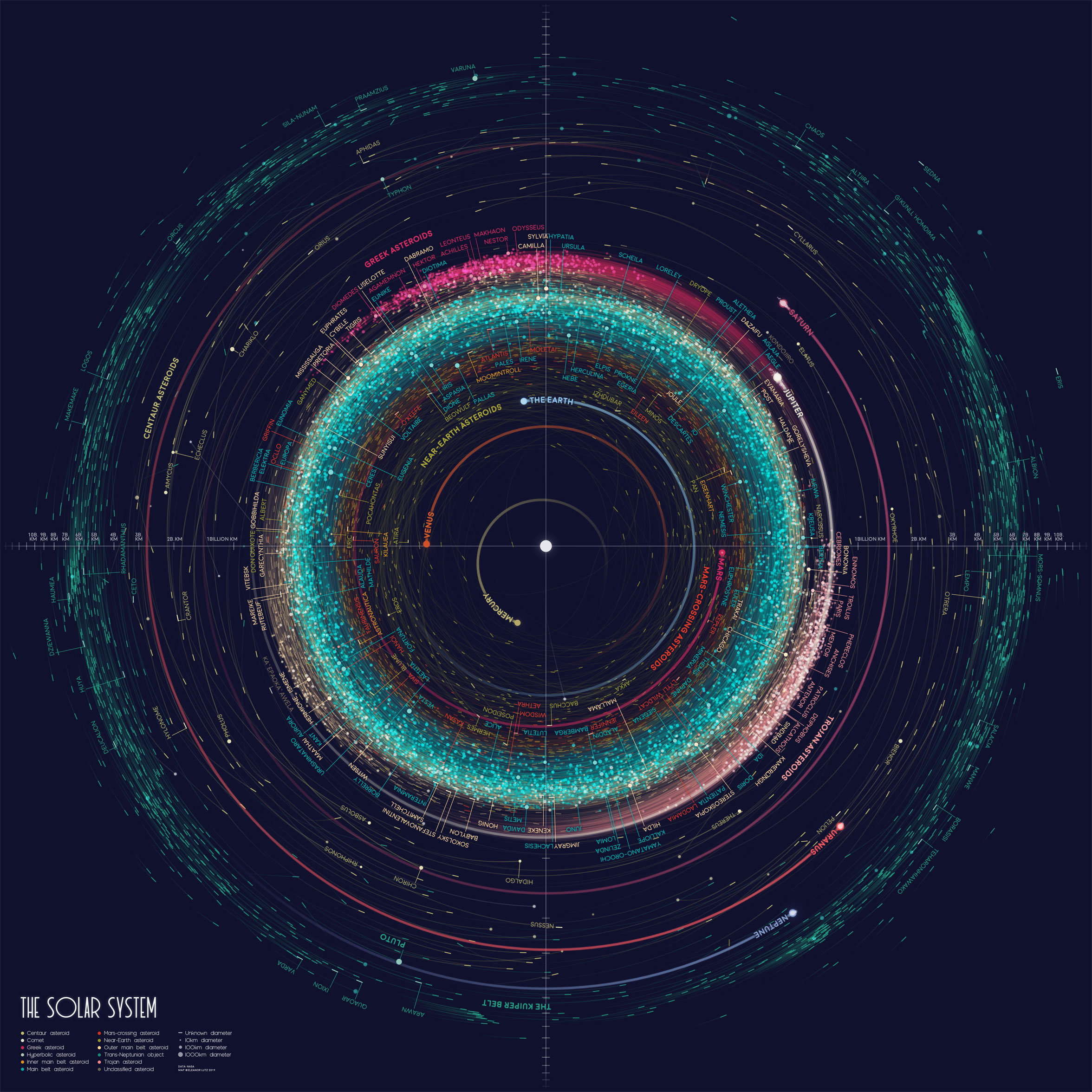An Orbit Map of the Solar System
June 10 2019 · Link to the Open-Source Code
This week’s map shows the orbits of more than 18000 asteroids in the solar system. This includes everything we know of that’s over 10km in diameter - about 10000 asteroids - as well as 8000 randomized objects of unknown size. This map shows each asteroid at its exact position on New Years’ Eve 1999.
All of the data for this map is shared by NASA and open to the public. However, the data is stored in several different databases so I had to do a decent amount of data cleaning. I’ve explained all of the steps in detail in my open-source code and tutorial, so I’ll just include a sketch of the process here in this blog post:

One of the most challenging parts of this map was figuring out how to make everything legible. It turns out that things in the solar system are distributed somewhat logarithmically. There are exponentially more things closer to the sun, and exponentially more smaller things than big things. So I used a radial logarithmic scale to include large things, far-away things, and tiny, nearby things on the same map. Logarithmic maps aren’t particularly common, but in this case I figured it was ok since no one would use this map for navigation.

 For this map I used the NASA HORIZONS server to generate orbit paths centered around the sun. But HORIZONS can also generate orbits centered around anywhere else. From left to right, these rosettes show the surprisingly beautiful paths of Mercury, Venus, Mars, Jupiter, Saturn, and Uranus as seen from Earth. Venus in particular has been described through history as the Pentagram of Venus or the Rose of Venus.
For this map I used the NASA HORIZONS server to generate orbit paths centered around the sun. But HORIZONS can also generate orbits centered around anywhere else. From left to right, these rosettes show the surprisingly beautiful paths of Mercury, Venus, Mars, Jupiter, Saturn, and Uranus as seen from Earth. Venus in particular has been described through history as the Pentagram of Venus or the Rose of Venus.
In a dataset of this size, there were so many exceptions that I designed this map using design “guidelines” rather than rules. For example, at first I wanted to map each asteroid with an orbit tail reaching back 10 years. But many asteroids didn’t have enough data, and the inner asteroids moved so fast that the map was illegible from overlapping lines. So in the end the asteroid tails reach back to the last possible data point, or 10 years, or a quarter of the object’s orbit - whichever is smallest.
The name labels are also fairly arbitrary. I tried to label all the largest and most important asteroids, like the ones we’ve investigated with spacecraft. I also included every named object in the outer solar system because this data is pretty sparse. Since I didn’t have room for all the rest, I picked out my personal favorites, like Moomintroll, O’Keefe, and Sauron. Sadly there was no asteroid named Eleanor, but you can find out if your own name is an asteroid by searching the JPL Small-Body Database Browser.

 Some early Python experiments on visualizing orbital paths. In these drafts I used data from the moons of Neptune, Jupiter, and Saturn, because a few dozen moons are much easier to manage than several thousand asteroids. Although I didn’t end up using the code, I still really like the orbit ribbon diagram (the ribbon thickness shows the orbit movement in the z axis).
Some early Python experiments on visualizing orbital paths. In these drafts I used data from the moons of Neptune, Jupiter, and Saturn, because a few dozen moons are much easier to manage than several thousand asteroids. Although I didn’t end up using the code, I still really like the orbit ribbon diagram (the ribbon thickness shows the orbit movement in the z axis).
One last fun fact about this map - you might notice that Pluto is shown inside Neptune’s orbit. It turns out that about 10% of the time, Pluto is actually closer to the sun than Neptune. On 12/31/99 Pluto is further away, but it appears closer here because Neptune’s orbit tail reaches back in time to a point when it was closer to the sun. (I actually didn’t know about this before the project, so I spent a long time trying to find the bug in the code before finally realizing that the map was working as it should).
-
Sources
- Data: NASA HORIZONS, NASA Jet Propulsion Laboratory. © 2019 California Institute of Technology. Object Classification, NASA PDS: Small Bodies Node. © JPL Solar Dynamics Group. Planets and Pluto: Physical Characteristics, NASA Jet Propulsion Laboratory. © 2001 California Institute of Technology. Planetary Satellite Physical Parameters, NASA Jet Propulsion Laboratory. © California Institute of Technology. NEO Earth Close Approaches, NASA Jet Propulsion Laboratory. © 2019 California Institute of Technology, CNEOS Center for Near Earth Object Studies. TNO and Centaur Diameters, Albedos, and Densities V1.0, W.R. Johnston. © 2018 NASA Planetary Data System. Reference texts: Astronomy, Andrew Fraknoi, David Morrison, Sidney C. Wolff et al. © 2016 OpenStax. Fonts: The labels on this map are typeset in Moon by Jack Harvatt. The title font is RedFlower by Type & Studio. Advice: Thank you to Jeff Heer, Chloe Pursey, and Leah Willey for their helpful advice in making this map.

© This work is shared under a Creative Commons Attribution-NonCommercial-NoDerivatives 4.0 International License.